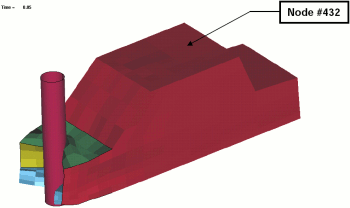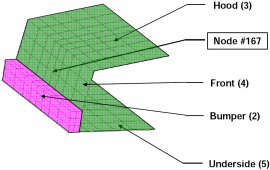In this example a direct optimization method, the Genetic Algorithm, is used instead of a metamodel-based approach to solve the optimization problem explained in Crashworthiness Optimization.
The problem is of a simplified vehicle moving at a constant velocity and crashing into a pole.
 |
 |
| Fig. 1(a): Deformed vehicle after 50 ms |
Fig. 1(b): Design variables with part numbers |
The problem illustrates the following features:
- A direct simulation-based optimization (Direct Genetic Algorithm)
- Dealing with an infeasible design formulation
- Use of composite functions
- Use of the LS-DYNA result interfaces
|
The criteria of interest are the following:
- Head injury coefficient (HIC) of a selected point (15ms)
- Component Mass of the structural components (bumper, front, hood and underside)
- Intrusion computed using the relative motion of two points
Design variables:
- The hood, front and underside (parts 3, 4 and 5 in Fig. 1(b)) are grouped under a single design variable: thood
- The bumper (part 2 in Fig. 1(b)) is identified as another design variable: tbumper
|
The design formulation is as follows:
- Minimize HIC(15 ms) subject to Intrusion (50 ms) < 550 mm and mass < 0.5. The intrusion is measured as the distance between the nodes 167 and 432 (for the location of the nodes see Fig. 1).
Problem Solution
⇒ Solution with LS-OPT

